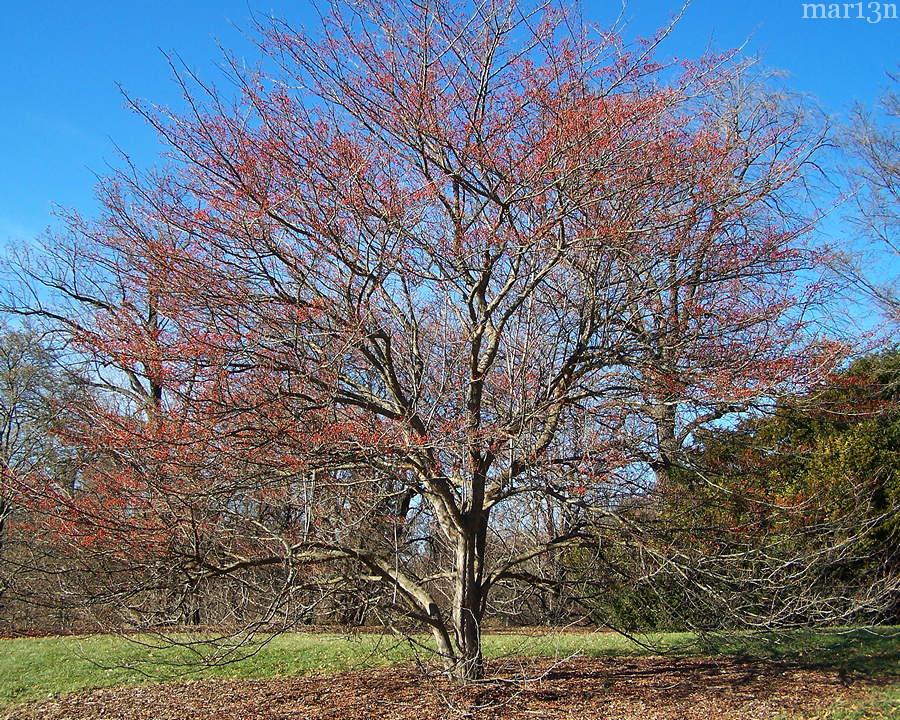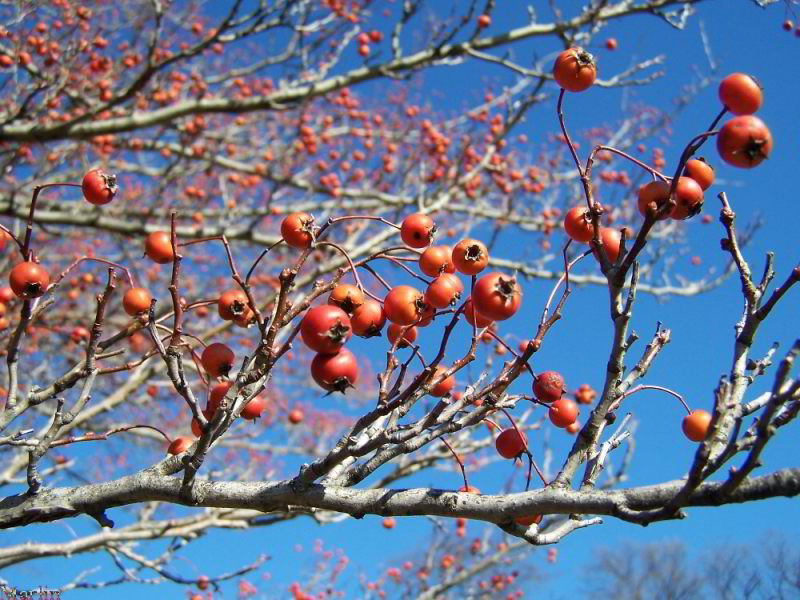Green Hawthorn – Crataegus viridis ‘Winter King’
 This Winter King Green Hawthorne gets its name from the outstanding profusion of winter-persistent red berries
This Winter King Green Hawthorne gets its name from the outstanding profusion of winter-persistent red berries
Family Rosaceae – Rose Family. Crataegus viridis ‘Winter King’ – is virtually the only commercial form available for this species, selected for near-thornlessness, orange-gray trunk and silvery-gray branches, vased growth habit, and Winter-persistent red-orange fruits that are larger than the species form; the species form (Green Hawthorn) has a more upright oval habit, numerous thorns, fewer flowers and fruits, and a more greenish, exfoliating bark.
Short stature makes this a good selection for tight spaces. Use as a hedge, single specimen, screen, or mass planting are all excellent possibilities. It is usually best without a backdrop, but if one is necessary, light colors are superior or else the foliage becomes lost in the background. If only planted for winter interest, plantings in front of dark evergreens such as yews or hemlocks will stand out nicely. (2)
˜Winter King™ Green Hawthorn is a North American native tree which slowly reaches 20 to 30 feet in height and spread (Fig. 1). It is very dense and thorny which makes it a popular choice for use as a hedge or as a screen. Unlike other Hawthorns, the thorns are small and inconspicuous. The dark green, deciduous leaves turn beautiful shades of bronze, red, and gold in the fall before dropping. The handsome, silver-grey bark peels off in sections to reveal the inner orange bark, making ˜Winter Kingâ Green Hawthorn a striking specimen planting in the winter landscape. The white blooms are followed by large, orange/red fruits which persist on the naked tree throughout the winter, adding to its landscape interest. (1)

USDA hardiness zones: 4 through 7. Crataegus is Latin for “strength”, referring to its wood.
1/4 to 1/2″ in diameter, the brilliant red fruit start forming in late September or early October. They cover the tree quite nicely, persisting through the winter months. Taxonomic description: Drupe, 1/4 to 1/2″ wide, subglobose or short-ellipsoid, red with yellow mealy flesh, 2-5 nutlets.
Opening in mid-May, the 2″ clusters of white 3/4″ blossoms show up nicely against the glossy green foliage. Like most members of the family Rosaceae, each individual flower has five petals, and like most hawthorns, they tend to be somewhat malodorous.
This beautiful tree is the ideal plant for those wanting year-round interest in their garden. Its small size lends itself to even the smallest gardens, and its tolerance in adverse conditions is admirable. Soils can be of any type, although Winter King hawthorns are happiest in loam. City conditions don’t seem to affect it either, but it does require full sun. (2)
References
1. USDA Forest Service Fact Sheet
2. Hort.net Crataegus viridis ‘Winter King’ L
2. Liset Crabapple, Morton Arboretum acc. 50-84-1, 2 & 3 photos by Bruce Marlin
3. Morton Arboretum Crabapples For The Home Landscape
Family Rosaceae – Rose Family; Fruit Trees
Many of these plants are of vital economic importance, the fruit of which contain vitamins, acids, and sugars and can be used both raw and for making preserves, jam, jelly, candy, wine, brandy, cider and other beverages.
Tree Encyclopedia | Tree Index | Fruit Tree Index
